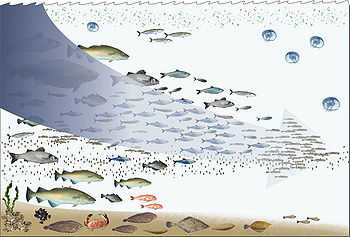

The environmental impact of fishing includes issues such as the availability of fish, overfishing, fisheries, and fisheries management; as well as the impact of industrial fishing on other elements of the environment, such as bycatch.[1] These issues are part of marine conservation, and are addressed in fisheries science programs. According to a 2019 FAO report, global production of fish, crustaceans, molluscs and other aquatic animals has continued to grow and reached 172.6 million tonnes in 2017, with an increase of 4.1 percent compared with 2016.[2] There is a growing gap between the supply of fish and demand, due in part to world population growth.[3]
Fishing and pollution from fishing are the largest contributors to the decline in ocean health and water quality. Ghost nets, or nets abandoned in the ocean, are made of plastic and nylon and do not decompose, wreaking extreme havoc on the wildlife and ecosystems they interrupt. Overfishing and destruction of marine ecosystems may have a significant impact on other aspects of the environment such as seabird populations. On top of the overfishing, there is a seafood shortage resulting from the mass amounts of seafood waste, as well as the microplastics that are polluting the seafood consumed by the public. The latter is largely caused by plastic-made fishing gear like drift nets and longlining equipment that are wearing down by use, lost or thrown away.[4][5]
The journal Science published a four-year study in November 2006, which predicted that, at prevailing trends, the world would run out of wild-caught seafood in 2048. The scientists stated that the decline was a result of overfishing, pollution and other environmental factors that were reducing the population of fisheries at the same time as their ecosystems were being annihilated. Many countries, such as Tonga, the United States, Australia and Bahamas, and international management bodies have taken steps to appropriately manage marine resources.[6][7]
Reefs are also being destroyed by overfishing because of the huge nets that are dragged along the ocean floor while trawling. Many corals are being destroyed and, as a consequence, the ecological niche of many species is at stake.
| Food types | Greenhouse gas emissions (g CO2-Ceq per g protein) |
|---|---|
| Beef | |
| Recirculating aquaculture | |
| Trawling fishery | |
| Non-recirculating aquaculture | |
| Pork | |
| Poultry | |
| Dairy | |
| Non-trawling fishery | |
| Eggs | |
| Starchy roots | |
| Wheat | |
| Maize | |
| Legumes |
- ^ Frouz, Jan; Frouzová, Jaroslava (2022). Applied Ecology. doi:10.1007/978-3-030-83225-4. ISBN 978-3-030-83224-7. S2CID 245009867.
- ^ Food and Agriculture Organization of the United Nations (FAO) (2019). "Fishery and Aquaculture Statistics 2017" (PDF). Archived (PDF) from the original on 2019-10-26.
- ^ "Global population growth, wild fish stocks, and the future of aquaculture | Shark Research & Conservation Program (SRC) | University of Miami". sharkresearch.rsmas.miami.edu. Retrieved 2018-04-02.
- ^ Laville, Sandra (2019-11-06). "Dumped fishing gear is biggest plastic polluter in ocean, finds report". The Guardian. Retrieved 2022-05-10.
- ^ Magazine, Smithsonian; Kindy, David. "With Ropes and Nets, Fishing Fleets Contribute Significantly to Microplastic Pollution". Smithsonian Magazine. Retrieved 2022-05-10.
- ^ Worm, Boris; et al. (2006-11-03). "Impacts of Biodiversity Loss on Ocean Ecosystem Services". Science. 314 (5800): 787–790. Bibcode:2006Sci...314..787W. doi:10.1126/science.1132294. PMID 17082450. S2CID 37235806.
- ^ Juliet Eilperin (2 November 2006). "Seafood Population Depleted by 2048, Study Finds". The Washington Post.
- ^ Michael Clark; Tilman, David (November 2014). "Global diets link environmental sustainability and human health". Nature. 515 (7528): 518–522. Bibcode:2014Natur.515..518T. doi:10.1038/nature13959. ISSN 1476-4687. PMID 25383533. S2CID 4453972.